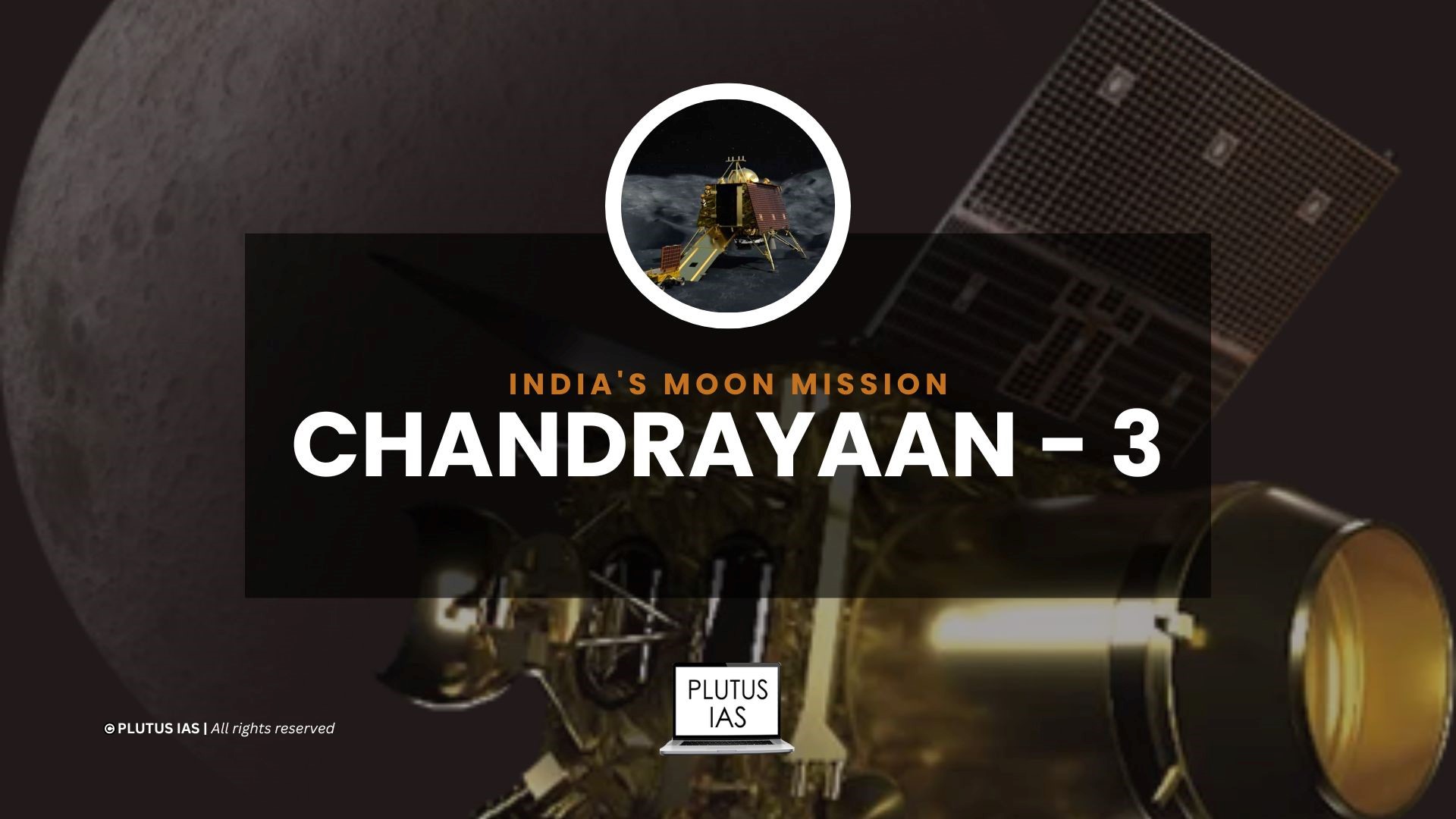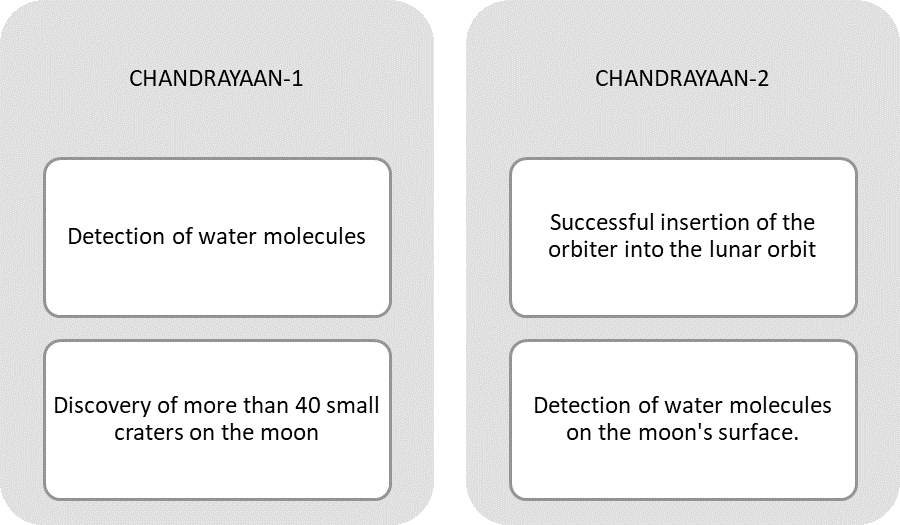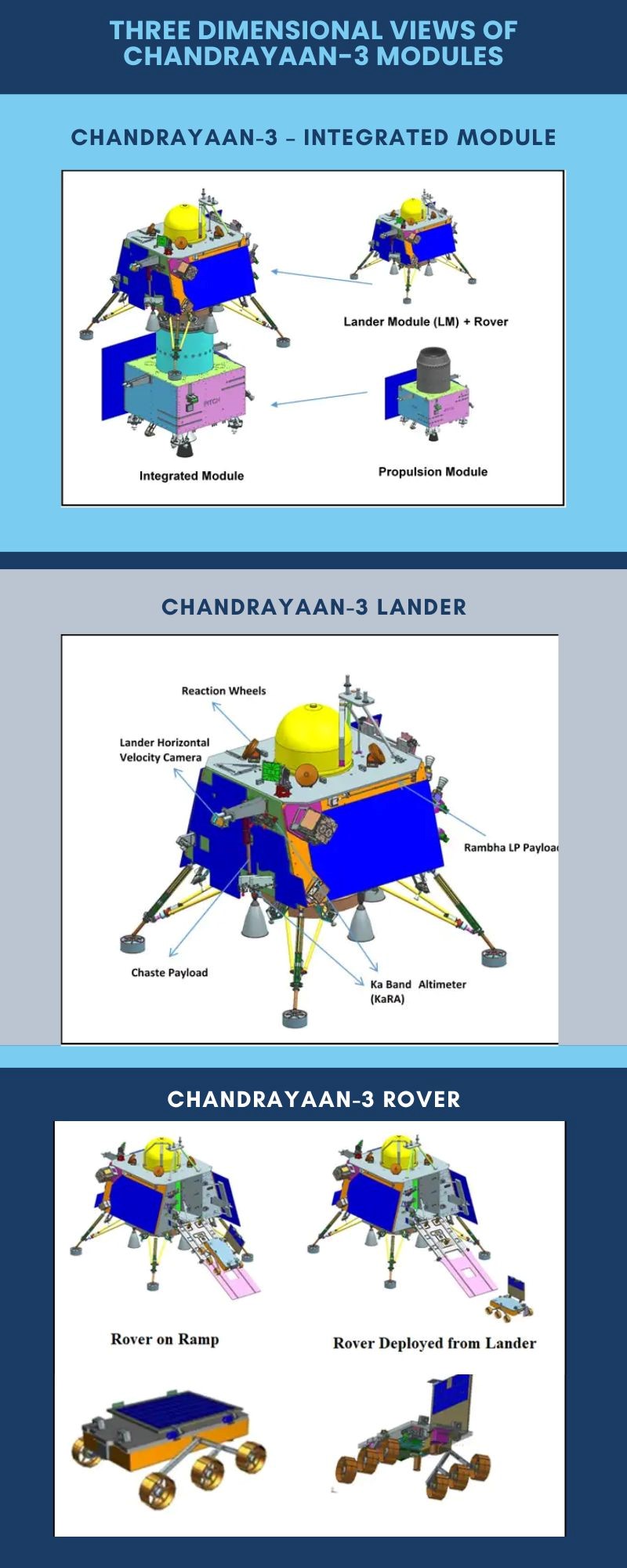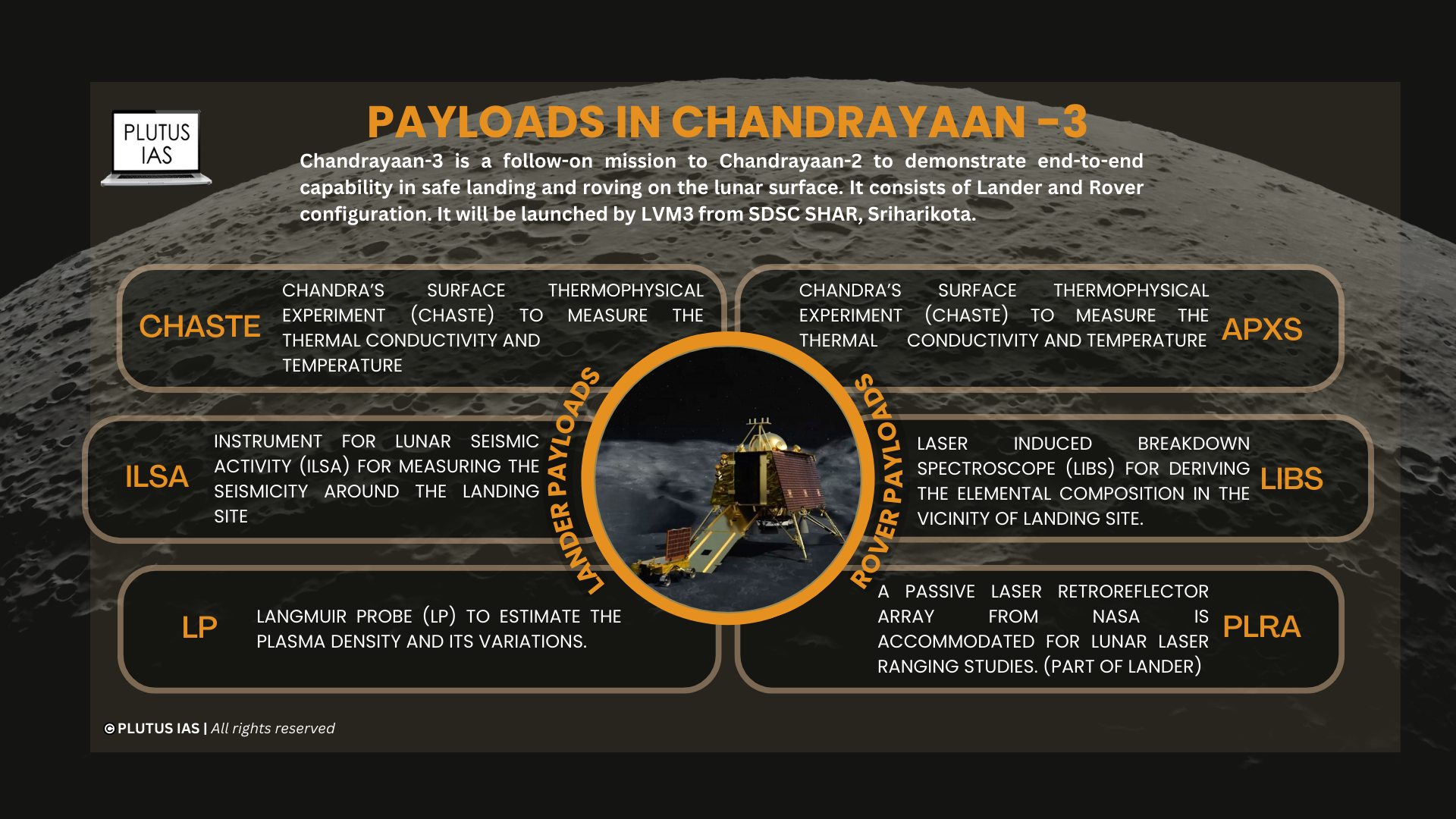02 Mar INDIA’s MOON MISSION – CHANDRAYAAN – 3
INDIA’s MOON MISSION – CHANDRAYAAN-3
This article covers “Daily Current Affairs for UPSC” and the topic details India’s endeavor to land its feet on the moon. Moon has always been a topic of inquisitiveness and mystery in the science arena. The topic is important in the context of India’s ambitious Chandrayaan 3 mission, to display end-to-end capability in safe landing and roving on the lunar surface.

Moon Mission
For Prelims:
- Findings of Chandrayaan series of missions
- Lunar Polar Exploration Missions
- Different types of Launch Vehicle and Orbits.
For Mains: GS 3, Science and Technology
- Details of Space Technology
- Chandrayaan 3 mission and its related significance
- Different Types of Launch Vehicles and their revolution
- Different types of Orbits and their significance
CONTENTS
- Why in news?
- What is the historical background of India’s moon missions?
- What is Chandrayaan-3 mission?
- What are the features of the Chandrayaan-3 mission?
- What is the significance of the Chandrayaan-3 mission?
- What are the Challenges associated with the Chandrayaan-3 mission?
- Way Forward
Why in news?
Recently, India’s premier space agency Indian Space Research Organisation (ISRO) was successful in a key test for Chandrayaan-3, India’s third moon mission. The cryogenic engine that will power the launch vehicle for the mission was successfully tested.
What is the historical background of India’s moon / Chandrayaan-3 missions?
The first mission in the series, Chandrayaan-1, was launched on October 22, 2008, and was India’s first lunar mission. The mission consisted of an orbiter and an impactor that was used to study the moon’s surface. The mission’s major objectives were to create a three-dimensional map of the moon’s surface and study the mineral composition of the moon. Chandrayaan-1 was a remarkable success, and the mission’s major discoveries included the detection of water molecules on the moon’s surface and the discovery of more than 40 small craters on the moon.
The second mission in the series, Chandrayaan-2, was launched on July 22, 2019. The mission was more ambitious than the previous mission and consisted of an orbiter, a lander, and a rover. The mission’s primary objective was to soft land the lander and rover on the moon’s south pole and study the lunar surface in greater detail. Despite the soft landing failure of the Vikram lander, the Chandrayaan-2 mission achieved several significant milestones, including the successful insertion of the orbiter into the lunar orbit and the detection of water molecules on the moon’s surface.

Chandrayaan-1 and Chandraan-2
ISRO is now preparing for the Chandrayaan-3 mission, which is a follow-up mission to the Chandrayaan-2 mission. The mission’s primary objective is to land a rover on the moon’s south pole and continue the scientific exploration of the moon.
What is Chandrayaan-3’s mission?
The Chandrayaan mission is a series of lunar exploration missions undertaken by the Indian Space Research Organisation (ISRO) to explore the moon’s surface, its mineral composition, and the presence of water molecules. The name “Chandrayaan” is derived from two Sanskrit words: “Chandra” (moon) and “Yaan” (vehicle). The Chandrayaan-3 mission is a lunar probe mission. It will have an orbiter and a landing module. It is a follow-up to the Chandrayaan-2 mission. The failure of the Chandrayaan-2 mission led to the making of another mission to demonstrate end-to-end capability in safe landing and roving on the lunar surface. The mission is proposed to be carried out in 2024 in partnership with Japan.

Chandrayaan-3
What are the features of the Chandrayaan-3 mission?
The following are some of the expected features of the Chandrayaan-3 mission:
- Mission Objective: The primary objective of the Chandrayaan-3 mission is to conduct a soft landing on the Moon’s surface, deploy a rover, and conduct various scientific experiments.
- Launch Date and Vehicle: The launch date for Chandrayaan-3 has not been announced yet. The mission is expected to be launched using the Geosynchronous Satellite Launch Vehicle Mark III (GSLV Mk III) rocket.
- Payloads: The Chandrayaan-3 mission is expected to carry a range of scientific payloads, including a lunar rover, a seismometer, and a thermal profiler. These payloads will help in studying the lunar surface and its environment.
- Landing Site: The Chandrayaan-3 mission is expected to land near the South Pole of the Moon, which is an unexplored region that is of great scientific interest.
- Mission Duration: The Chandrayaan-3 mission is expected to have a mission duration of around 14 days. During this time, the lander and rover will conduct various scientific experiments and collect data.
- Mission Cost: The total cost of the Chandrayaan-3 mission is estimated to be around Rs 610 crore.

chandrayaan mission 3
What is the significance of the mission?
The importance of the Chandrayaan-3 mission lies in the following areas:
- Scientific Exploration: The mission aims to continue the scientific exploration of the moon and build on the discoveries made by the previous missions. The mission will carry advanced scientific instruments to study the lunar surface and its geology, mineralogy, and topography.
- Technological Advancement: Chandrayaan-3 will be equipped with advanced technology and equipment developed by Indian scientists and engineers. The mission will provide an opportunity to test and demonstrate new technologies for future space exploration.
- Lunar Exploration: The mission aims to land on the moon’s south pole, which is an area that has not been explored in detail before. The south pole region of the moon is believed to have water ice, which could be used as a resource for future human missions to the moon.
- Boosting India’s Space Program: The successful completion of the third mission will further boost India’s status as a leading spacefaring nation and showcase its technological capabilities and commitment to space exploration.
- Geopolitical Importance: Chandrayaan’s mission helped to elevate India’s status in the global community as a leading spacefaring nation. The successful completion of the Chandyayaan 3 will demonstrate India’s technological capabilities and its commitment to exploring space for scientific and societal benefits.
It will build on the successes of the previous mission and provide valuable information for future lunar exploration and space missions.

Chandrayaan-3 launch
What are the Challenges associated with the Chandrayaan-3 mission?
The Chandrayaan-3 mission, like any space exploration mission, will face several challenges. Some of the significant challenges that the mission might face are:
- Technical Challenges: Developing and testing the advanced technologies required for the mission, including the lander, rover, and orbiter, will be a significant technical challenge. The mission will also have to overcome the soft landing failure of the Vikram lander in the previous mission.
- Complex Mission Design: The mission aims to land on the moon’s south pole, which presents a complex landing site due to its rugged terrain and low temperatures. The mission will require precise planning and execution to ensure a successful landing.
- Funding and Resources: The mission requires significant funding and resources for its successful completion. The mission’s budget must be allocated efficiently to ensure the timely development and launch of the mission.
- Environmental Challenges: The extreme conditions on the moon, such as the low temperatures and radiation, pose significant challenges for the mission’s equipment and instrumentation. The mission must develop and test equipment that can withstand these conditions.
Overcoming these challenges will require precise planning, efficient resource allocation, and advanced technological solutions.
Way Forward
The Chandrayaan-3 mission is a critical mission for India’s space program, and several steps can be taken to ensure its success. Here are some ways forward for the Chandrayaan-3 mission:
- Technical Development: Robust testing and simulations must be carried out to ensure that the equipment and instrumentation can withstand the harsh lunar environment.
- Mission Design: The mission’s landing site and trajectory must be precisely planned to ensure a successful landing. The lander and rover’s design must also be adapted to the terrain and environmental conditions at the landing site.
- Resource Allocation: The necessary funding and resources must be made available to support the mission’s objectives and goals.
- International Collaboration: Collaboration with international partners can provide valuable support and expertise in the development and execution of the mission.
By implementing these steps, the mission can ensure its success and achieve its scientific and technological objectives.
Download the Pdf Now:
PLUTUS IAS CURRENT AFFAIRS 2nd March 2023
Daily Current Affairs for UPSC
Get the latest and the best daily current affairs for the UPSC examination for Plutus IAS. The topic related to current affairs is based on Science and technology. The topic described above is talking about the moon mission. Also, read the weekly and monthly current affairs for the IAS exam preparation. Nowadays, daily current affairs are the main elements of the UPSC exam preparation. So, every aspirant should read the updated daily current affairs for the UPSC examination regularly.




No Comments